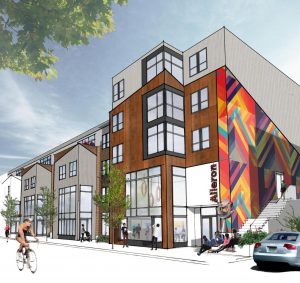Tiny House, tremendous ambitions
A new club, Team Tiny House, is set to have an exhibit at the Northern Virginia Science Center.
A Sketchup model of Team Tiny House’s project. “Tiny houses affect people right now because [they involve] sustainable practices that can be implemented as soon as we invent them,” Junior Amith Polineni said.
September 15, 2022
Junior Maribelle Chu noticed a gap in the world of Jefferson’s engineering teams—while they built rockets, launched satellites, and raced robots, there was nothing with a more grounded focus: improving the sustainability of the communities we live in.
“None of the engineering clubs at [Jefferson] were focused on promoting sustainability and the environment,” Chu said. “I wanted to combine those passions of environment and engineering.”
To do this, Chu created Team Tiny House. The group will design and build a tiny home with sustainable technologies, and deploy it at a new science museum in Loudoun County.
“Tiny House is an organization of 30 students who are passionate about engineering, environment and community. We give our members engineering experience,” Chu said, “We’ve talked with the Northern Virginia Science Center Foundation and we are going to have a tiny house exhibit there when we’re done building [it]. We’re also going to have our tiny house shown throughout the community and festivals.”
The publicly-accessible nature of the Tiny House, as co-president and junior Amith Polineni explains, truly connects the project to the local community.
“It’s going to be a tiny house that people can walk inside and tour. There’ll be plaques everywhere to display our sustainable practices. People can learn about these practices or scan a QR code to buy something for their own home,” Polineni said. “This will be an open exhibit for anyone to visit. We’re hoping [to] launch it in the summer of next year, but the science center is still being built. As soon as it’s ready, our tiny house will also be ready.”
The sustainable technologies that Team Tiny House uses include eco-friendly, repurposed materials.
“One example [of a sustainable practice] is reusing second hand windows and doors,” Polineni said. “By repurposing windows and doors that might be going to a landfill, we give them a new life.”
This focus on second hand material also helped Team Tiny House overcome one of their obstacles: cost.
“One challenge for any beginning team is raising money to buy the materials. We need to become a nonprofit so we can give companies their nonprofit tax return,” Chu said. “But then, in order to become a nonprofit [it] takes three to six months from the IRS. In order to do that, you need paperwork. And money to submit that. It’s a lot more complicated than people think.”
So far, Team Tiny House has split into teams to overcome these issues, and their project is well underway.
“We have six sub teams: business, public relations, interior construction, renewable energy, electrical smart home,” Chu said. “It’s going amazingly well so far. We have a dedicated team and we’re very excited to see what we can do in the future.”

![A Sketchup model of Team Tiny House's project. "Tiny houses affect people right now because [they involve] sustainable practices that can be implemented as soon as we invent them,” Junior Amith Polineni said.](https://www.tjtoday.org/wp-content/uploads/2022/09/SmartSelect_20220914_131950_Instagram.gif)







